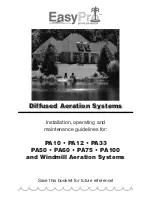
EcoSolar Energy Conscious Design Limited
2
supplied to the hot water cylinder. The efficiency of a system is often overstated or misinterpreted,
two of the most common overstated efficiency levels are outlined below;
•
97% efficiency
– we have heard salespersons promoting that a system is 97% efficient. This
level of efficiency is only for the absorber within the collector i.e. the absorber within a collector,
which historically was a matt black high temperature paint is often now a selective coating which is
able to receive high levels of solar gain and only reflects back a very low percentage.
•
70% efficiency
– this level of efficiency is often the peak collector efficiency and will certainly
not be delivered and maintained in practice. This collector efficiency reduces as the water is heated
above the ambient (outside) temperature.
Selecting the most appropriate system
Selecting the right system for a customer can be split into three;
•
Type of system
– the type of system is key to ensure system reliability and is dependent upon
the climatic conditions of the site and how the customer will use the system.
•
Size of system
– this is key to the performance of the system and delivering acceptable energy
savings
•
System operation and control
– there are several levels of system operation and control, the
selection of these is dependent upon how much the customer is willing or able to manually intervene
and control the system.
Type of system
The types of solar hot water system include, thermosyphon systems, pumped systems, drainback
systems, indirect and direct systems. Each of these systems has advantages and disadvantages that
should be understood so that by the most appropriate system is recommended to the customer. For
instance a remote site without reliable power could have a thermosyphon system installed, see Figure
1 below, which requires no power but will probably have a lower efficiency and may require
increased maintenance, alternatively a pumped drainback system could be installed, see Figure 2
below, that would potentially utilise a 12Volt controller (see Figure 3) and pump, the system would
be more efficient, would address the issues of freezing and overheating but may be more expensive
to install than a thermosyphon system.
A batch with an intermittent hot water demand or a house with a variable hot water demand would
probably have a drainback system installed, as this system is able to manage overheating in a fail-safe
manner







































